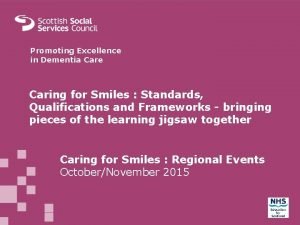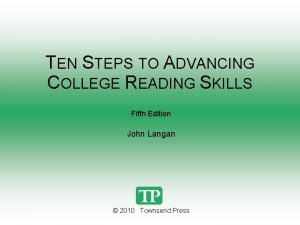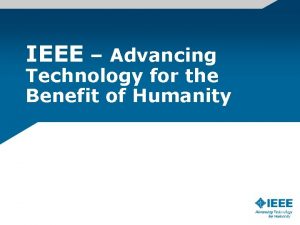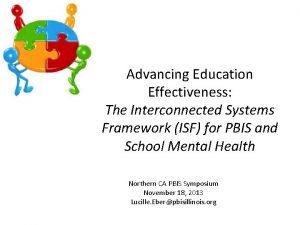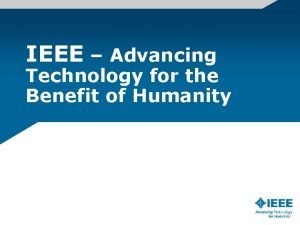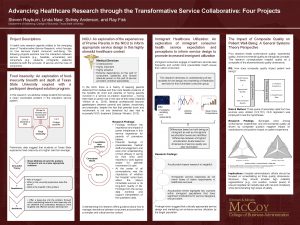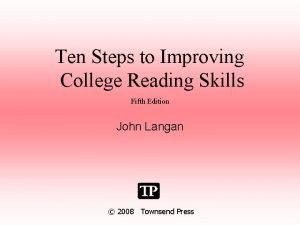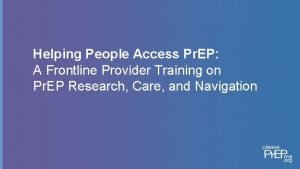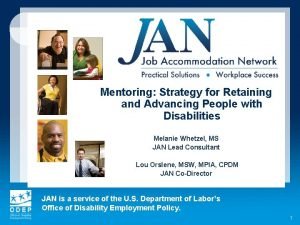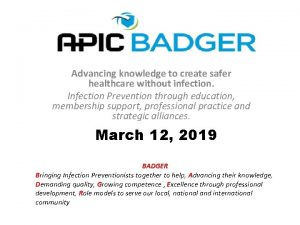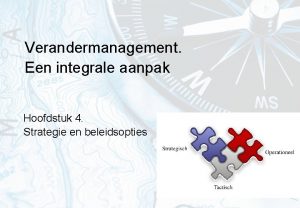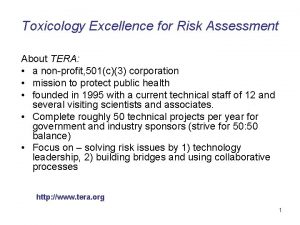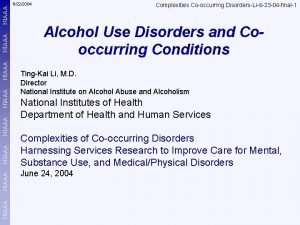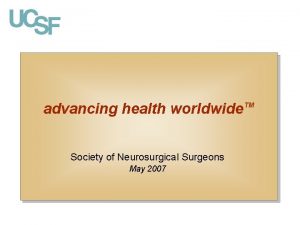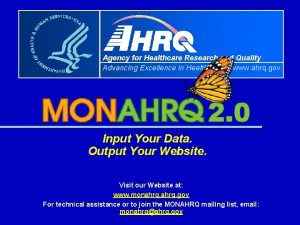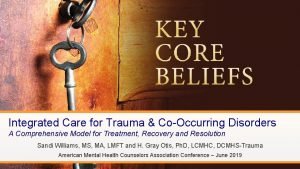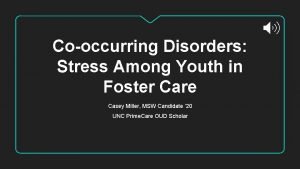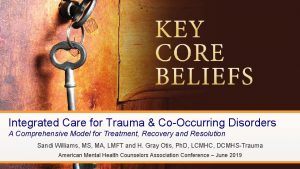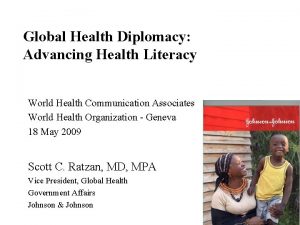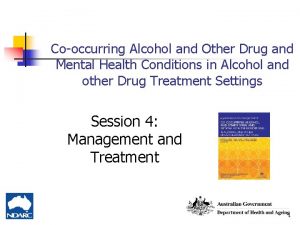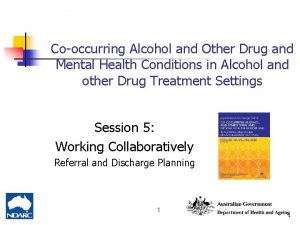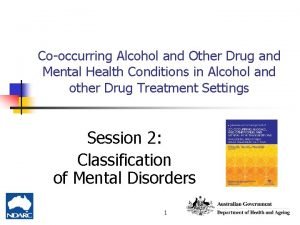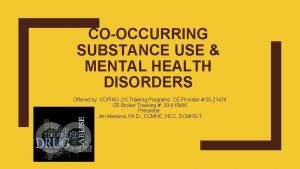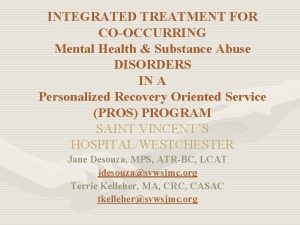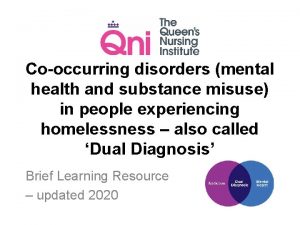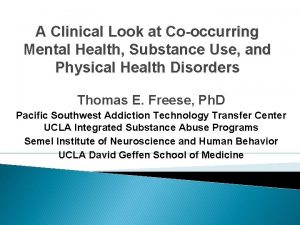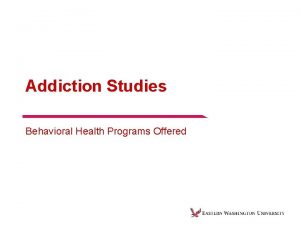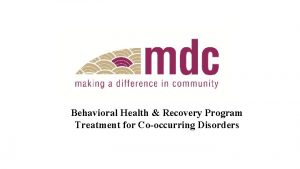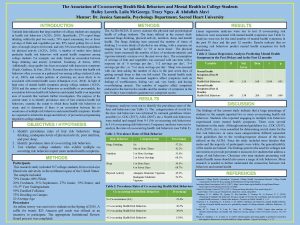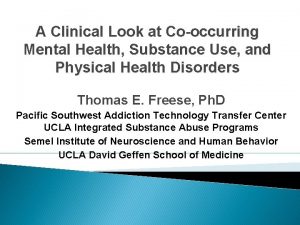Advancing Excellence in Health Care Complexities of CoOccurring






































- Slides: 38

Advancing Excellence in Health Care: Complexities of Co-Occurring Conditions Helen Burstin, MD, MPH Director, Center for Primary Care, Prevention, and Clinical Partnerships CCC Conference June 24, 2004

Overview n About AHRQ: The Evidence Agency n Improving Quality and Reducing Disparities n Mental Health and Substance Abuse at AHRQ n Opportunities and Challenges

AHRQ Research Focus: How it Differs n Patient-centered, not disease-specific n Dual Focus -- Services + Delivery Systems Effectiveness research focuses on actual daily practice, not ideal situations (“efficacy”) n AHRQ mission includes production and use of evidence-based information

New AHRQ Mission Statement To improve the quality, safety, efficiency, and effectiveness of health care for all Americans

AHRQ Research and Knowledge Transfer n Building the knowledge base: – The Effectiveness Question: What works? n Clinical n Organizational – How do we get people/systems/policymakers to do or use what works? n How do we support the widespread implementation of what works? n How do we sustain evidence based practice?

Knowledge Transfer Strategies n Involving Users in Research Cycle n Partnering for Translation and Dissemination n Partnering for Implementation and Evaluation n Research Networks n Research Collaboratives n Focus on Results – Measuring impact – Systematic evaluations

Evidence-based Practice Centers n Systematically reviews scientific literature on clinical, behavioral, and organization and financing topics n Conducts research on methodologies and the effectiveness of their implementation n Requires nomination by an organization who will use the reports to support quality improvement

Examples of EPC Topics n Impact of financial incentives on the delivery of clinical preventive services n Rating systems for strength of scientific evidence n Best practices for priority conditions n MH/SA: pharmacologic therapy for alcoholism, depression, ADHD, and dementia

The National Guideline Clearinghouse www. guideline. gov n Emphasis on transferring evidence -based knowledge to health care professionals n Structured summaries of guidelines n Includes “syntheses, ” guideline comparisons, and annotated bibliographies n Numerous guidelines on approximately 20 different MH/SA diagnoses.

Overview n About AHRQ: The Evidence Agency n Improving Quality and Reducing Disparities n Mental health and substance abuse at AHRQ n Opportunities and Challenges

RAND Study: Quality of Health Care Often Not Optimal Patients’ care often deficient, study says. Proper treatment given half the time. On average, doctors provide appropriate health care only half the time, a landmark study of adults in 12 U. S. metropolitan areas suggests. Medical Care Often Not Optimal. Failure to Treat Patients Fully Spans Range of What Is Expected of Physicians and Nurses Medical errors corrode quality of healthcare system Study: U. S. Doctors are not following the guidelines for ordinary illnesses The American healthcare system, often touted as a cutting-edge leader in the world, suddenly finds itself mired in serious questions about the ability of its hospitals and doctors to deliver quality care to millions.

Healthcare Research and Quality Act (PL. 106 -129) n “Beginning in fiscal year 2003, the Secretary, acting through the Director, shall submit to Congress an annual report on national trends in the quality of health care provided to the American people. ” n Annual report to the Congress on “prevailing disparities in health care delivery as it relates to racial factors and socioeconomic factors in priority populations. ”

NHQR/NHDR: Key Findings n Only 20. 9% of patients with diabetes receive all recommended tests n 90% of adults are screened for high blood pressure – but only 25% are controlled n Nearly 1/3 of adults and children with asthma do NOT receive effective Rx n Almost 80% of patients diagnosed with depression do not have optimal levels of contact with their health care provider.

NHQR/NHDR: Mental Health Data Limitations: n Need additional measures for mental disorders other than depression n Need better data on vulnerable populations n Insufficient data to track the quality of mental health treatment for young adults or the elderly

Getting to Improvement n Making research findings usable – now: www. qualitytools. ahrq. gov n Partnerships with professional organizations, federal agencies, communities and patients n New links to SAMHSA (National Mental Health Information Center) and NIMH (Health Information) information

Overview n About AHRQ: The Evidence Agency n Improving Quality and Reducing Disparities n Mental health and substance abuse at AHRQ n Opportunities and Challenges

How has practice changed?

Percent of Americans Saying “I Have A Chronic Condition” Chronic Illness and Caregiving Survey, Harris 2000

Beneficiaries With 5 or More Chronic Conditions Account for Two-Thirds of Medicare Spending Source: Medicare 5% Sample, 2001 Gerry Anderson, JHU

Most Adults Have Multiple Chronic Conditions Source: Medical Expenditure Panel Survey, 2000 Gerry Anderson, JHU

Depression and Utilization n For 8 common conditions, depression increases odds: – 2. 1 -3. 2 of ER visit – 2. 6 -3. 7 of hospitalization – 1. 7 -2. 7 of preventable hospitalization Gerry Anderson, JHU


Practice-Based Research Networks (PBRNs) 36 new PBRN grants awarded in 2002 19 PBRN grants awarded in 2000

Practice-based Research Networks n Groups of primary care providers that work together to study questions related to community-based practice n Provide strategies to translate research into practice n 45 regional/national networks of community health centers, clinics, practices, and HMOs n Support from NIMH

PBRNs and Study of MH/SA* * PBRN Resource Center Survey of 83 PBRNs

Prescription for Health: RWJ-AHRQ Initiative n PBRNs develop creative, practical strategies to promote healthy behaviors that can be easily adopted by other primary care practices. n $9 million research/QI initiative n 4 health risk behaviors: smoking, risky drinking, sedentary lifestyle; and unhealthy diet – 7/17 projects: interventions to reduce risky drinking

US Preventive Services Task Force n Independent panel of experts in primary care and prevention n Evaluates the scientific evidence for a range of preventive services (i. e. counseling, screening, and preventive medications) n Makes recommendations on whether a clinical preventive service should be routinely delivered

USPSTF and MH/SA n Recommends screening adults for depression in clinical practices that have systems in place to assure accurate diagnosis, effective treatment, and follow-up. Screening improves the accurate identification of depressed patients in primary care settings – Treatment of depressed adults identified in primary care settings decreases clinical morbidity. – n Insufficient evidence to recommend for or against routine screening by primary care clinicians to detect suicide risk in the general population.

USPSTF and MH/SA n Recommends screening and behavioral counseling interventions to reduce alcohol misuse by adults, including pregnant women, in primary care settings – Insufficient evidence to recommend for or against screening and behavioral counseling interventions to prevent or reduce alcohol misuse by adolescents in primary care settings. n Insufficient evidence to recommend for or against routine screening of parents or guardians for the physical abuse or neglect of children, of women for intimate partner violence, or of older adults or their caregivers for elder abuse.

Overview n About AHRQ: The Evidence Agency n Improving Quality and Reducing Disparities n Mental Health and Substance Abuse at AHRQ n Opportunities and Challenges

Bridging the Quality Chasm Where We Are Where We Want To Be Implementation Innovation Health IT Diffusion Adoption TRIP

Diffusion of Innovation n “Invention is hard; dissemination is much more difficult”. n A problem for all industries. n Influences on rate of diffusion: – Perception of innovation – Characteristics of individuals who adopt change – Contextual and managerial factors

Where is US Health Care and IT?

The “CPR Adoption Gap”: The United States Versus Others Primary Care Physician Office CPR Use by Country, 2002 Source: "European Physicians Especially in Sweden, Netherlands, and Denmark, Lead U. S. in Use of Electronic Medical Records. " Harris Interactive Health Care News 2(16).

Health Information Technology n AHRQ Investment: $60 M – $26 M: to implement proven technologies in small and rural communities where HIT penetration has been low – $24 M: targeted for developing, implementing, and evaluating the use of new and innovative technologies to improve patient safety and quality of care in diverse health care settings – $10 M: targeted for clinical data standards and interoperability

Questions in Search of Answers n Linking knowledge development to policy levers (e. g. , payment; regulation): role of ‘demonstrations’ n When is “good enough”? n Vocabulary and pathways for translation of knowledge-based interventions underdeveloped n Concurrent -- or sequential -- evaluation and translation?


For additional questions, please contact: Dr. Helen Burstin, hburstin@ahrq. gov
 Qualitative quantitative
Qualitative quantitative Levels of care primary secondary tertiary
Levels of care primary secondary tertiary Promoting excellence in dementia care
Promoting excellence in dementia care Unit 2 equality diversity and rights
Unit 2 equality diversity and rights Health and social care component 3
Health and social care component 3 10 steps to advancing college reading skills
10 steps to advancing college reading skills Ten steps to advancing college reading skills
Ten steps to advancing college reading skills Ronald lee in advancing
Ronald lee in advancing Advancing vocabulary skills 4th edition
Advancing vocabulary skills 4th edition Ten steps to advancing college reading skills
Ten steps to advancing college reading skills Advancing colours
Advancing colours Ieee advancing technology for humanity
Ieee advancing technology for humanity Chapter 11 sentence check 1 clandestine
Chapter 11 sentence check 1 clandestine Advancing vocabulary skills 4th edition
Advancing vocabulary skills 4th edition Advancing education effectiveness
Advancing education effectiveness Ten steps to advancing college reading skills answers
Ten steps to advancing college reading skills answers Caries that spurts up with advancing age
Caries that spurts up with advancing age Advancing vocabulary skills 4th edition
Advancing vocabulary skills 4th edition Advancing vocabulary skills 4th edition
Advancing vocabulary skills 4th edition Rowing upstream meaning
Rowing upstream meaning Advancing technology for humanity
Advancing technology for humanity Advancing of loans
Advancing of loans Advancing vocabulary skills 4th edition
Advancing vocabulary skills 4th edition Advancing healthcare research
Advancing healthcare research 10 steps to improving college reading skills
10 steps to improving college reading skills Gilead advancing access
Gilead advancing access Ten steps to advanced reading
Ten steps to advanced reading Mentoring circle
Mentoring circle Advancing technology for humanity
Advancing technology for humanity Advancing knowledge in healthcare
Advancing knowledge in healthcare Standard 3 care certificate
Standard 3 care certificate Ce atrage magnetul
Ce atrage magnetul Palliative care vs hospice care
Palliative care vs hospice care Mamiferele se înmulțesc prin ouă
Mamiferele se înmulțesc prin ouă Care sunt simturile prin care sunt evocate
Care sunt simturile prin care sunt evocate Care certificate standard 13
Care certificate standard 13 Hip fracture clinical care standard
Hip fracture clinical care standard Waardestrategieën van treacy en wiersema
Waardestrategieën van treacy en wiersema Toxicology excellence for risk assessment
Toxicology excellence for risk assessment


